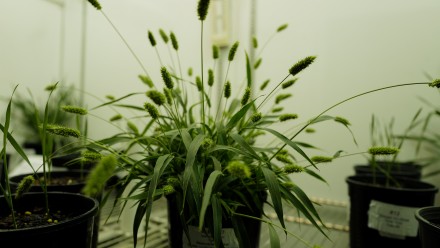Exploring the combined response of heat and drought on photosynthesis and respiration of C4 plants
Global earth temperature has increased by 1.4°C since 1910 and is still increasing, with 2023 being the warmest on record (NASA, 2024). Heat and drought are becoming increasingly common which makes them major abiotic stresses for plant production (Lamaoui et al., 2018). In addition, Australia has warmed, on average, by 1.5°C since 1910 and is predicted to do so for the next decades (King et al., 2017). Such degree of warming will inevitably affect plant physiology by altering photosynthesis and respiration, ultimately hammering the yield and survival chance of plants. C4 plants, with high photosynthesis, are more efficient in hot and dry climates. Understanding how C4 plants respond to heat and drought will potentially allow us to overcome the current limits of photosynthesis in different plants and help us design crops for improved food and energy production.
Australia is a global hotspot of C4 plants that consist of important crops (e.g. maize, sorghum and sugarcane) and widely spread native/bioenergy grasses (e.g. switchgrass and foxtail miller). It is the best place to understand the response of C4 plants to future climate change. Some information is available in the literature: warming reduced photosynthesis under moderate precipitation but not under drought in C4 blue bluestem, suggesting that C4 photosynthetic response depends on the drought level (Hoover et al., 2014; 2017). Such response to drought may also vary with the C4 biochemical types and phylogeny of the plants. There are three distinct C4 biochemical types (namely, NADP-ME, NAD-ME and PCK types), with each type using a specialised enzyme for photosynthesis. It has been shown that NADP-ME species are more susceptible to drought compared to NAD-ME species in Panicoideae and NADP-ME species in Aristidoideae, as a result of different stomatal control and metabolic impairment (Raubenheimer et al., 2023). However, no information was available for the PCK type or how this variation in drought response interacts with warming. This project aims to disentangle the interaction between warming and drought on plant physiology in phylogenetically related C4 species of the three types. The focus will be on using species from Family Poaceae that include crops (e.g. maize) and bioenergy grass (e.g. miscanthus). This study will support future C4 research aiming to identify the genetic basis of temperature- and drought-tolerant plants.
Interested students are encouraged to contact Yuzhen Fan (yuzhen.fan@anu.edu.au).
References:
Hoover DL, Knapp AK, Smith MD. 2014. Contrasting sensitivities of two dominant C4 grasses to heat waves and drought. Plant Ecol. 215:721–31.
Hoover DL, Knapp AK, Smith MD. 2017. Photosynthetic responses of a dominant C4 grass to an experimental heat wave are mediated by soil moisture. Oecologia 183:303–13.
King, A., Karoly, D. & Henley, B. 2017. Australian climate extremes at 1.5°C and 2°C of global warming. Nature Clim Change 7, 412–416.
Lamaoui M, Jemo M, Datla R, Bekkaoui F. 2018. Heat and drought stresses in crops and approaches for their mitigation. Front. Chem. 6: 26.
NASA 2024. Global temperature. https://climate.nasa.gov/vital-signs/global-temperature/?intent=121
Raubenheimer SL, Venter N, Ripley BS. 2023. Drought susceptibility of southern African C4 grasses: Phylogenetically and photosynthetically determined? Functional Ecology 37: 2029–2039.





